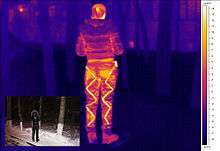Heated clothing



Most heated clothing is designed for cold-weather sports and activities, such as motorcycle riding, downhill skiing, diving, winter biking, and snowmobiling, trekking and for outdoor workers such as construction workers and carpenters.
Normal insulation works by trapping body heat, so if it gets wet from sweat or rain, or if a person stops exercising, the insulation may not keep them warm. With heated garments, a person can keep warm even if they are resting and not producing heat, or if their coat is damp from sweat.
Types
By function
The most widely available types of heated clothing are products for the extremities- the hands and feet. These body parts are the most likely to suffer frostbite or frostnip in severe cold. As such, many manufacturers make heated gloves, mittens, socks, and boot liners, and they can be purchased at workers' supply stores (serving construction workers) and motor sports stores. Heated torso coverings (vests or jackets) or leggings are available from specialty retailers that cater to motorcyclists and downhill skiers.
A related product is heated seat covers, throws, and seating pads. Heated seat covers for snowmobiles, motorcycles, and cars and heated "throw blankets" typically use electrical 12 volt heating elements. Heated seating pads for hunting, canoeing, and stadium use either have rechargeable batteries or they use a reheatable gel pack.
Technology
Electrical
Heated clothing designed for use on vehicles such as motorbikes or snowmobiling typically use 12 volt electric current, which is the standard voltage on motorsports or powersports batteries. While a single heated garment, such as heated gloves will not usually adversely affect the charge on the battery, riders have to be careful about attaching several heated garments, such as a heated boot liners, gloves, and a heated vest, because the battery may not be able to handle the load. The heated garments are usually attached directly onto the battery of the bike. Some heated garments have cigarette lighter plugs, so that the clothing can be plugged into a car's cigarette lighter. While the least expensive models can only be turned on or off, the more expensive models sometimes provide a heating level control.
For downhill skiing or winter biking, rechargeable batteries are generally used, either nickel metal hydride battery technology or lithium batteries. If not recharged properly, "battery memory" will shorten the battery's capability to recharge. With lithium batteries, there are two types: Li-ion & Li-Polymer. There are several heating technologies employed including copper wire, nichrome wire, metal "mesh' systems, carbon-embedded fabric and carbon fibers. The most reliable systems have technologies that have redundancy in case of a heating element breakage. If the weather is a little warmer, in many models the controller and battery can be detached, so that the garment can be worn as a regular garment.
Stored heat
Garments that use gel have cloth pouches or pockets where plastic packages of gel can be inserted in the garment. Prior to going outdoors, the gel is heated up in a microwave. Once outdoors, the gel pack retains its heat for between 30 minutes and two hours, depending on the size of the gel pack, the thickness of the insulation protecting the gel pack from the outdoor temperatures, and the outdoor temperature and wind conditions.
Chemical
Chemical reaction-based garments have cloth pouches or pockets where single-use packages of chemical hand warmers can be inserted. The hand warmers are about the size of a package of cards, and they contain chemicals which produce heat. One traditional hand warmer is a small metal box containing charcoal which, when lit, burns very slowly and produces a mild heat. Disposable heat packs typically contain cellulose, iron, water, activated carbon, vermiculite and salt. When these packs are exposed to air, an exothermic chemical reaction occurs, which provides several hours of heat. Another chemical heating pad uses a gel that can be activated by twisting the package, thus triggering a chemical reaction. The pack can be put in a pot of boiling water to convert the chemical reaction back, and allow it to be reused. While these products are commonly called "hand warmers", they can be placed in boots or, with special garments such as vests, in cloth pockets on the inside of the garment. The temperature tends to be lowest among above heating methods.